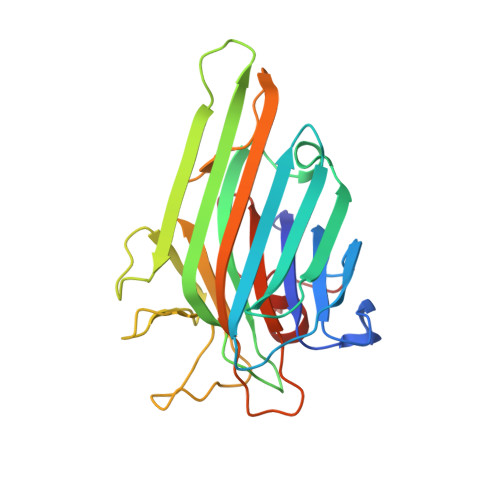Insights Into the Structural Basis of the Ph- Dependent Dimer-Tetramer Equilibrium Through Crystallographic Analysis of Recombinant Diocleinae Lectins.
Nagano, C.S., Calvete, J.J., Barettino, D., Perez, A., Cavada, B.S., Sanz, L.(2008) Biochem J 409: 417
- PubMed: 17937659
- DOI: https://doi.org/10.1042/BJ20070942
- Primary Citation of Related Structures:
2JDZ, 2JE7, 2JE9, 2JEC - PubMed Abstract:
The structural ground underlying the pH-dependency of the dimer-tetramer transition of Diocleinae lectins was investigated by equilibrium sedimentation and X-ray crystal structure determination of wild-type and site-directed mutants of recombinant lectins. Synthetic genes coding for the full-length alpha-chains of the seed lectins of Dioclea guianensis (termed r-alphaDguia) and Dioclea grandiflora (termed r-alphaDGL) were designed and expressed in Escherichia coli. This pioneering approach, which will be described in detail in the present paper, yielded recombinant lectins displaying carbohydrate-binding activity, dimer-tetramer equilibria and crystal structures indistinguishable from their natural homologues. Conversion of the pH-stable tetrameric r-alphaDGL into a structure exhibiting pH-dependent dimer-tetramer transition was accomplished through mutations that abolished the interdimeric interactions at the central cavity of the tetrameric lectins. Both the central and the peripheral interacting regions bear structural information for formation of the canonical legume lectin tetramer. We hypothesize that the strength of the ionic contacts at these sites may be modulated by the pH, leading to dissociation of those lectin structures that are not locked into a pH-stable tetramer through interdimeric contacts networking the central cavity loops.
Organizational Affiliation:
Instituto de Biomedicina de Valencia, C.S.I.C., Jaime Roig 11, 46010 Valencia, Spain.

















